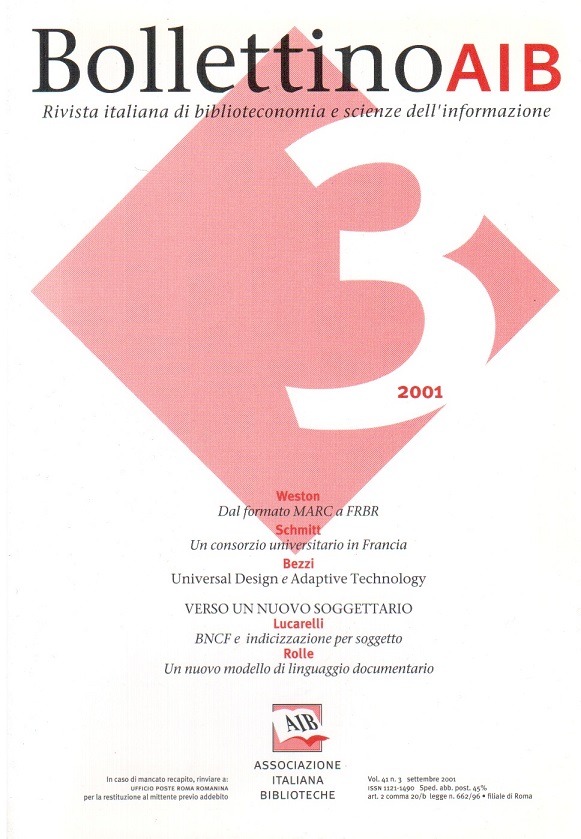UD and AT: what are they?
Main Article Content
Abstract
UD (Universal Design) and AT (Adaptive Technology) are the acronyms that define two elements that should becopme part of the general cultural and professional baggage of Italian libraries.
Through a list of the seven basic principles of Universal Design and a short illustration of what is meant by Adaptive Technology, it is attempted to sketch a new perspective, to associate with those already acquired, through which to look at the control and management of libraries - service ventures.
In universal planning the user is identified by the whole of the most extensive range of individual skills and abilities rather than by the traditional average user, an abstract "mathematical" representation of the needs of the majority.
These themes contain elements through the lens of which it is possible to filter ever aspect of managerial control, ranging from buildings to the use of electronic resources, from document delivery to accessibility of the on-line OPAC, from the marketing of services to the evaluation of the quality of the services.
The cue for reflection is offered by a limited review of what has been produced in recent years within the professional debate and the projects underway in the North-American and Anglosaxon spheres where the integration of the theme of disability with the strategic plan of the service ventures - library appears to be a widespread and shared reality.
Accessibility basically means that the library, its services and its technological and documentary resources are planned in such a way as to be easily used by all users whether they are physically present in the premises or remotely access its services - and this in a transparent manner with respect to disabilities or any access preference that they may have.
If the principles of universal planning (Design for All) are integrated with the technological services of the library including its web site, all users will be provided with the same level of access to the information and services. Access to the information can be guaranteed in more than one way: mainly through the use of adaptive technologies; secondly through the adoption of a correct method of interface creation and planning. The two ways are of equal importance: the provision of technological aids will guarantee the user with visual disability access to the information in electronic format in the way that is most suited to his needs but the information must be planned in the such a way that it is can be correctly interpreted by the support technology. The degree of effectivenss in the use of adaptive technology is closely linked to the awareness of the producers of information and those who act as information brokers.
Through a list of the seven basic principles of Universal Design and a short illustration of what is meant by Adaptive Technology, it is attempted to sketch a new perspective, to associate with those already acquired, through which to look at the control and management of libraries - service ventures.
In universal planning the user is identified by the whole of the most extensive range of individual skills and abilities rather than by the traditional average user, an abstract "mathematical" representation of the needs of the majority.
These themes contain elements through the lens of which it is possible to filter ever aspect of managerial control, ranging from buildings to the use of electronic resources, from document delivery to accessibility of the on-line OPAC, from the marketing of services to the evaluation of the quality of the services.
The cue for reflection is offered by a limited review of what has been produced in recent years within the professional debate and the projects underway in the North-American and Anglosaxon spheres where the integration of the theme of disability with the strategic plan of the service ventures - library appears to be a widespread and shared reality.
Accessibility basically means that the library, its services and its technological and documentary resources are planned in such a way as to be easily used by all users whether they are physically present in the premises or remotely access its services - and this in a transparent manner with respect to disabilities or any access preference that they may have.
If the principles of universal planning (Design for All) are integrated with the technological services of the library including its web site, all users will be provided with the same level of access to the information and services. Access to the information can be guaranteed in more than one way: mainly through the use of adaptive technologies; secondly through the adoption of a correct method of interface creation and planning. The two ways are of equal importance: the provision of technological aids will guarantee the user with visual disability access to the information in electronic format in the way that is most suited to his needs but the information must be planned in the such a way that it is can be correctly interpreted by the support technology. The degree of effectivenss in the use of adaptive technology is closely linked to the awareness of the producers of information and those who act as information brokers.
Article Details
Section
Articles

This work is licensed under a Creative Commons Attribution-ShareAlike 4.0 International License.
